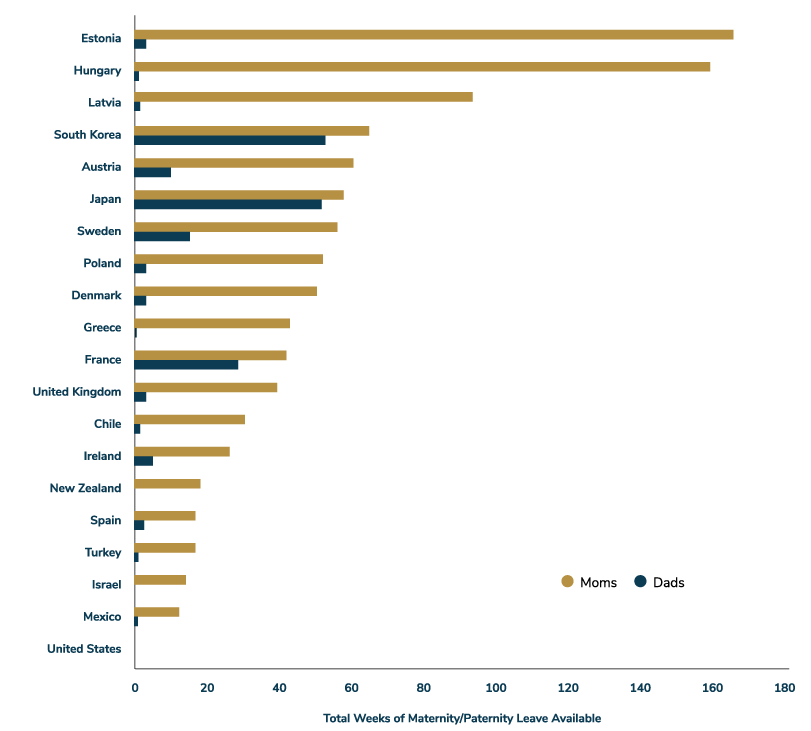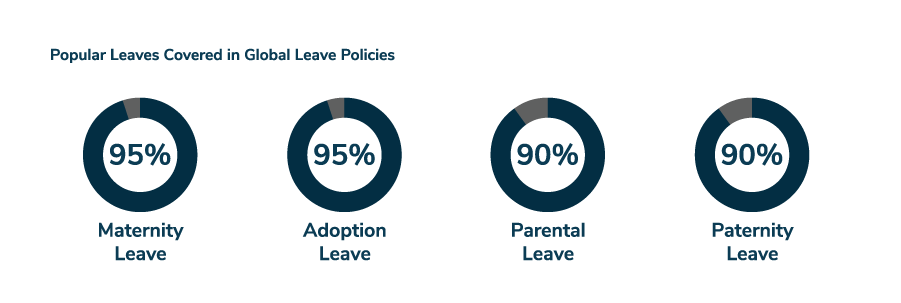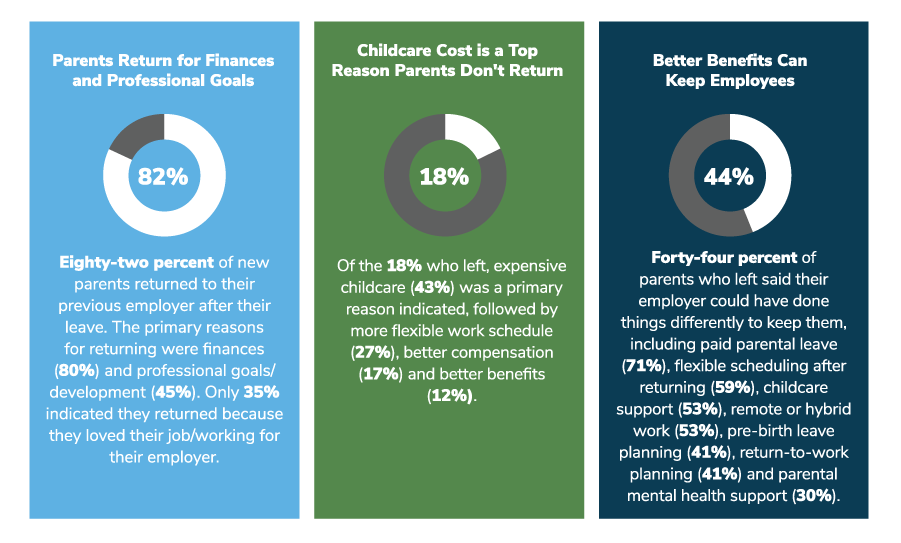November 11, 2022
Whether family changes are welcomed, distressing or come with mixed emotions, transitions can be difficult to navigate and impact employee well-being and productivity. This section shares ways employers can support employees as they welcome a child into their life, return to work after an extended leave or experience other major transitions, such as moving, military service, marriage or divorce.
Welcoming a Child
Paid parental leave is a top benefit new parents want and need. Evidence suggests paid family leave can decrease infant mortality rates, increase vaccination rates, extend breastfeeding duration, increase return-to-work likelihood, and reduce the risk of postpartum depression. According to Ovia Health’s recent survey, nearly half (45%) of new parents indicated that parental leave benefits were difficult to understand and access, and 76% indicated parental leave preparation would have been helpful. Moreover, parents had access to less paid parental leave than they needed—59% took 2 months or more of unpaid parental leave.
Table 3.1: Benefits for Welcoming a Child
| BENEFIT | LARGE EMPLOYER BENCHMARK |
|---|---|
| Breast pump | 100% |
| 24-hour access to a Certified Lactation Counselor | 33% |
| Short-term disability for medical-maternity leave (fully paid by employer, not voluntary benefit) | 93% |
| Parental leave (partially or fully paid) | 88% |
| Additional leave for more than 1 child (e.g., twins) | <5% |
| Non-parental/caregiver leave for other family members (e.g., new grandparents or uncles/aunts) | 7% |
| Digital tool/app for newborn care | 42% |
| Intranet page/hub with all parenting resources and information | 48% |
| Parental leave checklist to help employees and teams prepare for a leave | 54% |
| Conversation guide for managers and employees before a parental leave | 30% |
| Parental leave coverage plan template | 19% |
| BENEFIT | LARGE EMPLOYER BENCHMARK |
|---|---|
| Dedicated leave coordinator and/or leave navigation | 43% |
| Regular leave webinars/training for employees and/or managers | 9% |
| Leave calculator to help parents maximize time away or pay | 7% |
| Leave-sharing/donation program | 9% |
| Baby bonus (cash for new child) | <5% |
| Shower for all expecting parents | 9% |
| Congratulatory gift (e.g., letter/note while on leave, baby book(s), onesie with company logo) | 37% |
| Death benefits (spouse and/or child receive financial support from employer) | 33% |
| Assistance with naming a guardian | 36% |
| Estate planning/will or trust preparation | 46% |
Best Practices for Managers
- Congratulate the employee on their pregnancy and/or new child, as appropriate.
- Find out at what point the employee wishes to share the news with others.
- Provide the employee with any company resources, policies or checklists.
- Allow time off and flexible schedules for appointments.
- Discuss plans for leave start and return dates.
- Do not share any concerns about arranging coverage or budgets.
- Identify if any reasonable accommodations are needed.
- Make arrangements for coverage and communicate plans with the employee, including them in decisions whenever possible. This responsibility should be the manager’s—not the employee’s.
- Ask the employee about contact during parental leave (many find it helpful to be kept aware of workplace changes and invited to social events).
- If in any doubt, consult your HR team.
The Expanding Role of Men in Parenting and Caregiving
Men are taking on more caregiving and household responsibilities than ever before. According to the Pew Research Center, fathers spend, on average, 7 hours a week on child care—almost triple the time they provided in 1965. A 2021 study found Black and White men value and fulfill their parenting and caregiving responsibilities similarly, helping to dispel the harmful myth of the “absent Black father,” an idea perpetuated by structural racism. In fact, Black fathers (88%) are more likely than White fathers to think it’s very important to provide direct care to younger children, such as feeding, dressing or providing childcare.1
To support all male employees in their parental and caregiving roles, employers not only need to offer family leave to men, but they also need to encourage men to take it while ensuring that the company culture is supportive. Only 36% of male employees use all available parental leave.2 However, when dads do take parental leave, good things happen—men who take parental leave are glad they did and would do so again, notice improvement in their relationship with their partner, develop what they describe as a “special” bond with their child, and discover a newfound appreciation for their employer.3

Countries Around the World Beat the U.S. in Paid Parental Leave

Sources: OECD Family Database, Table PF2.1.A, 2018, Leave for Parents, 2021.
Large employers with global locations must navigate significant challenges to establish a program with globally consistent principles. Knowledge of current leave requirements, market practices (including cultural considerations) and existing company leave policies provide the foundation for developing a global framework and establishing key tenets to guide country-by-country variations for implementation.
According to the Business Group 2020 Leave Strategy and Transformation Survey, 19% of large employers with a global presence indicated that they have a global leave policy and another 19% were working on a policy or considering implementing one.

Thinking of developing a global leave policy? Here are some considerations from leave experts at Aon:
- Do you require market data to develop a business case?
- How will you get other pertinent groups—rewards, well-being, benefits & HR strategy, diversity & inclusion—involved and on board?
- Which approach will you take – country-by-country benefits or a consistent global approach?
- If you are expanding leave, how will you allocate resources to cover those out on leave?
- What types of cost modeling will be required? For example, actuarial analysis and/or factoring in all monetary implications across all time-away categories?
Returning to Work
Returning to work after a parental leave (or other extended leave) is a process that can take a toll on parents physically and emotionally. Many employees feel guilty, overwhelmed, tired and excited. A supportive workplace with flexibilities, such as gradual return-to-work schedules, and managers who encourage employees to be kind to themselves and appropriately reset expectations during this transition can help improve the employee experience.

Source: 2021 Ovia Health The Future of Family Benefits Survey
Table 3.2: Benefits for Return to Work After a Parental Leave
| BENEFIT | LARGE EMPLOYER BENCHMARK |
|---|---|
| Gradual return-to-work schedule (even better with full pay) | 28% |
| Parental leave checklist to help employees and teams reintegrate after a leave | 24% |
| Flexible work schedule | 78% |
| Predictable work hours for hourly employees | 17% |
| Hybrid work (e.g., 3 days in workplace, 2 days telework) | 44% |
| Remote work (full-time telework) | 26% |
| Return-to-work guidance/resources/training for managers | 20% |
| Paid break time to pump (unpaid—required by ACA; paid—better) | 78% |
| Permanent, dedicated space to pump (a clean, private space is required by ACA; permanent dedicated space is better) | 96% |
| Refrigerator or access to a refrigerator to store milk (with freeze section to freeze ice packs) |
60% |
| Sign-up system (online or via posted sheet) |
64% |
| Comfortable seating | 80% |
| Comfortable temperatur | 42% |
| Natural/soft lighting | 51% |
Sources: 2021 Family Benefits Quick Survey, 2022 Large Employers’ Health Care Strategy and Plan Design Survey, 2020 Supporting Employees with School-Aged Children During the Pandemic Quick Survey, 2018 Parental Benefits, Supports & Perks Quick Survey
| BENEFIT | LARGE EMPLOYER BENCHMARK |
|---|---|
| Calming decor and artwork | 42% |
| Full-length mirror | 20% |
| Clock | 44% |
| Access to electrical plugs | 76% |
| Hooks to hang attachment kit bags |
42% |
| Bulletin board for notices and photos of mothers and babies |
22% |
| Multi-user hospital grade breast pumps |
16% |
| A sink with hot and cold running water |
49% |
| Microwave for sterilization | 20% |
|
Access to pregnancy and |
62% |
| Daily cleaning regimen provided by company |
31% |
| Breastfeeding support group | 21% |
| Travel kits/shipping services during business travel | 23% |
| On-site health clinic | 44% |
| New parent mentoring/career coaching | 17% |
| No required travel for new parents policy | <5% |
| Return-to-work bonus | <5% |
For more information on Parental Leave, visit the Business Group's Parental Leave FAQs.
Best Practices for Managers
- Congratulate the employee on new child, as appropriate.
- Give consideration to flexibilities, such as part-time return-to-work, telework and flexible hours.
- Provide the employee with any company resources, policies or checklists.
- Allow time off and flexible schedules for appointments.
- Identify if any reasonable accommodations are needed.
- Ensure reasonable break time is provided for nursing birth parents in accordance with company policy and ACA requirements.
- Be flexible when reviewing requests and remember that people’s feelings and circumstances can and do change once a child arrives.
- Don’t assume the employee can “pick up where they left off.”
- If in any doubt, consult your HR team.
To learn more about ways to provide work coverage during for a parental leave or other extended leave, review the Business Group’s Strategies for Leave Coverage.
General Mills' Maternity and Parental Leave Planning Guide
General Mills’ Maternity and Parental Leave Planning Guide shares step-by-step instructions on how employees should plan for their leave and actions they’ll need to take after their child arrives, FAQs about the leave process, and helpful resources, like a checklist of key contacts and to-do items.
Major Life Changes: Marriage, Divorce, Military Service and More
Major life events that impact the entire family can affect employee well-being and productivity. Employers can step up to provide needed compassion during these moments that matter and support employees, spouses and dependents practically and emotionally through the stressful time.
Table 3.3: Benefits for Life Changes
| BENEFIT | LARGE EMPLOYER BENCHMARK |
|---|---|
| Financialguidance/assisstance (e.g., relevant to marriage and divorce) | 42% |
| Coverage for pre-marital and marriage counseling | 34% |
| Assistance buying and selling homes | 57% |
| Relocation bonus | 32% |
| Temporary living space, such as hotel or rental home, for moving transition | 60% |
| Financial assistance with moving expenses | 70% |
| Assistance finding jobs for spouses and partners who move with employees | 29% |
| Remote work (full-time) | 26% |
| Paid military leave | 90% |
| Special onboarding and/or re-integration program for veterans | <5% |
| BENEFIT | LARGE EMPLOYER BENCHMARK |
|---|---|
| Paid holiday for Memorial Day | 93% |
| Paid holiday for Veterans Day | 11% |
| Military/veterans' ERG | 62% |
| Veterans mentorship program | <5% |
| Onsite EAP | 35% |
| Telephonic EAP | 96% |
| Teletherapy | 88% |
| Digital cognitive behavioral therapy programs | 36% |
| Paid time off (including PTO, vacation/sick, unlimited/permissive) | 100% |
| Flexible schedules | 78% |
Life Events Impact Health and Well-being
Fidelity’s research, in collaboration with the Stanford Center on Longevity, found that common life events can have a strong impact on employee health and well-being. Moreover, Fidelity discovered that when employers offer more health, wellness and work-life benefits, employees are better able to manage stress and have better feelings about work.4

Source: Fidelity. Life Magnified: How Important Life Events Impact Total Well-being presented at: Workforce Strategy 2019; September 17, 2019; San Diego, CA.
- 1 | St. Julien J. A portrait of caring black men. New America’s Better Life Lab. February 4, 2021. https://www.newamerica.org/better-life-lab/reports/portrait-caring-black-men. Accessed July 27, 2021.
- 2 | Society for Human Resource Management. 2017 employee benefits: Remaining competitive in a challenging talent marketplace. 2017. https://www.shrm.org/hr-today/trends-and-forecasting/research-and-surveys/Documents/2017 Employee Benefits Report.pdf. Accessed July 27, 2021.
- 3 | McKinsey & Company. A fresh look at paternity leave: Why the benefits extend beyond the personal. March 5, 2021. https://www.mckinsey.com/business-functions/organization/our-insights/a-fresh-look-at-paternity-leave-why-the-benefits-extend-beyond-the-personal#. Accessed July 28, 2021.
- 4 | Fidelity Investments. The value of benefits. August 2020. https://sponsorcqa.fidelity.com/bin-public/06_PSW_Website/documents/The_value_of_benefits_employer_and_employee_perspectives.pdf. Accessed August 4, 2021.
-
Full GuideThe Family Benefits Bundle: Full Guide
-
Part 1The Family Benefits Bundle: Introduction
-
Part 2The Family Benefits Bundle: Family Building
-
Part 3The Family Benefits Bundle: Family Transitions
-
Part 4The Family Benefits Bundle: Parenting and Childcare
-
Part 5The Family Benefits Bundle: Caregiving
More Topics
Articles & Guides
This content is for members only. Already a member?
Login
![]()
